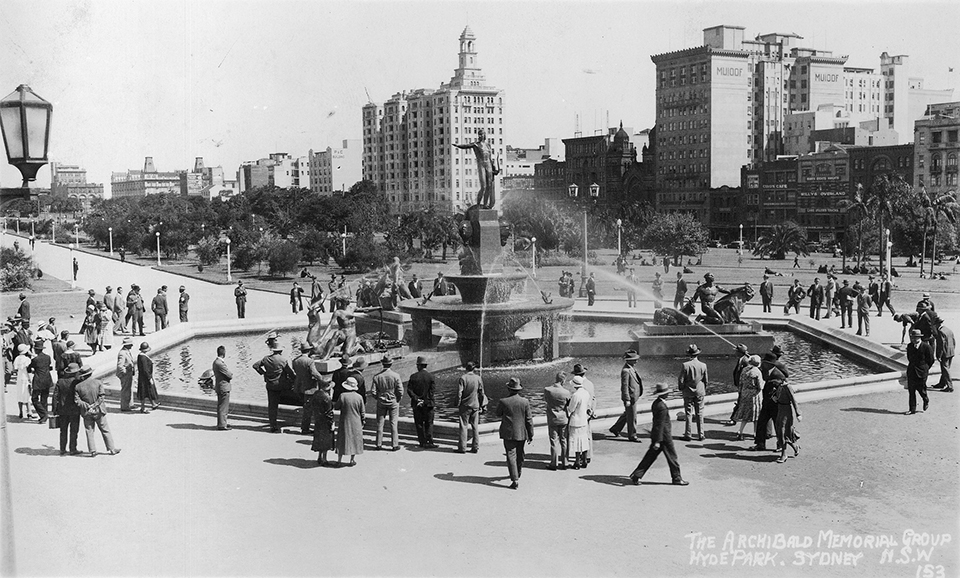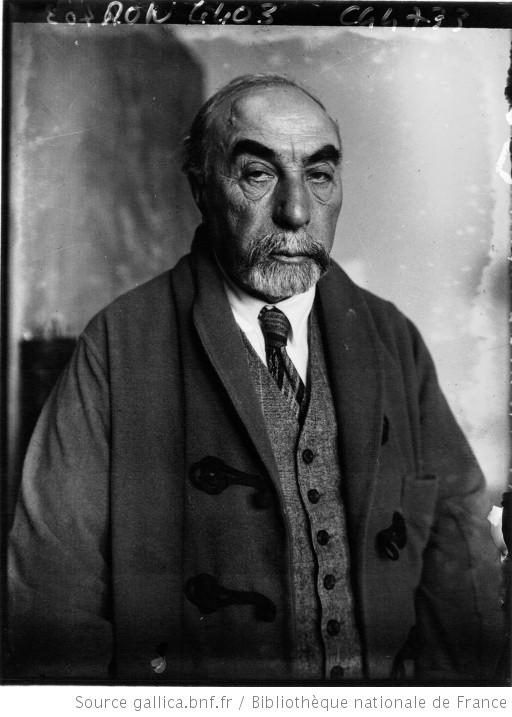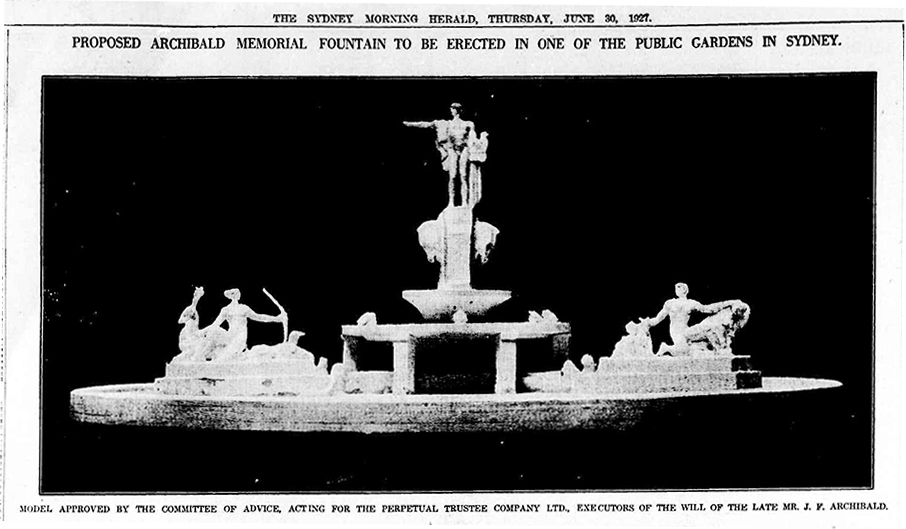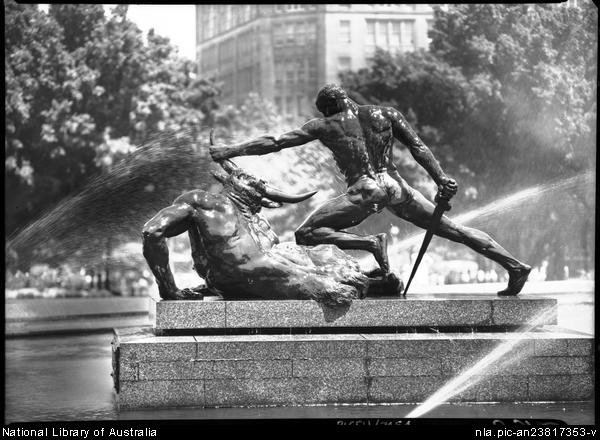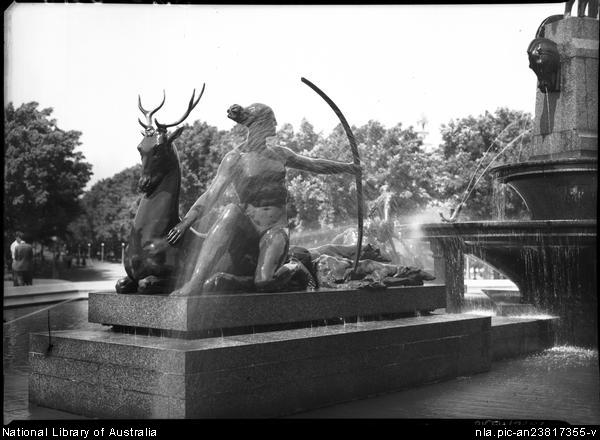The Dictionary of Sydney was archived in 2021.
Archibald fountain
Citation
Persistent URL for this entry
To cite this entry in text
To cite this entry in a Wikipedia footnote citation
To cite this entry as a Wikipedia External link
Archibald fountain
[media]Since its inauguration in March 1932, the Archibald Fountain in Hyde Park has become a much-loved feature of Sydney. The fountain resulted from a bequest by the founder and editor of The Bulletin, JF Archibald, who stipulated in his will that
a proportion of his estate should be devoted to the creation of some beautiful bronze symbolic open-air memorial by a French artist, commemorative of Australia and France having fought side by side for the liberties of the world. … such memorial to take the form of an electrically lighted fountain to be placed if possible in the Botanical Gardens Sydney or if not in some suitable place in one or other of the public gardens of Sydney.
The Francophile Archibald, who was baptised John Feltham but changed his name to Jules Francois, specified that the sculptor to design the fountain should be selected by the president of the Royal Academy of Arts in London. The provisions of Archibald's will were to be carried out by the Perpetual Trustee Company in Sydney.
Archibald's death
Archibald [media]died on 10 September 1919, but the planning and design of the fountain were delayed, according to his instructions, for another seven years, in order to increase the amount of money available for the commission. (The final amount was about £17,000.)
In early 1926, discussion began on a possible site for the memorial in the Botanic Gardens, then under the control of the New South Wales State Department of Agriculture. Soon afterwards, the director of the Art Gallery of New South Wales, Gother Mann, representing the Perpetual Trustee Company in London, approached Sir Frank Dicksee, the president of the Royal Academy of Arts in London, with the request that he recommend a suitable sculptor. Dicksee, a painter, consulted sculptor members of the academy and travelled to Paris with advisers to make the selection. By early August 1926, Mann was able to notify the trustees by cablegram that
DICKSEE SELECTS FRANCOIS SICARD SCULPTOR.
REQUESTS AUTHORITY TO ORDER PRELIMINARY SKETCHES.
A sculptor is selected
François-Léon Sicard, born in Tours in 1862, was [media]educated there and later at the Ecole Superieure des Beaux-Arts in Paris. In 1891 he won the coveted Prix de Rome, enabling him to study for three years at the French Academy in Rome. Returning to Paris, he became a teacher, and eventually a full professor, at the Ecole des Beaux-Arts. Sicard was best known in France for his large monument to the Convention Nationale, now in the apse of the Pantheon in Paris (in plaster, 1909–11; in stone, 1913–24).
Sicard had [media]never visited Sydney, but worked with the aid of photos and watercolour sketches of the proposed site. In May 1927 he submitted three models of the fountain to the committee appointed in London to consider them. Under the direction of the architect Bertrand Waterhouse, who on Mann's return to Sydney had replaced him as representative of the trustees, the committee included Lord Chelmsford as New South Wales Agent-General, Sir Frank Dicksee as the president of the Royal Academy of Arts in London, the sculptor Goscombe John and the Australian artist Lionel Lindsay.
On viewing the models, with Sicard present, the members unanimously recommended design A, the basis for the fountain in its final form.
The minutes of the meeting state:
The proposed site of the monument in relation to its surroundings was then discussed, and Mr Waterhouse stated that although the locality of the fountain in the Botanical Gardens had been definitely fixed, the Trustee Company might be prepared to consider suggestions as to the actual position and approach.
It was agreed that Major Hubert Corlette should make a site plan and submit it to the committee for consideration, and that a replica of Sicard's model should be immediately sent to Sydney. Waterhouse arrived back with the model aboard the Ormonde at the end of June 1927. 'The memorial', he told reporters, 'would be one of the finest fountains in the world'.
A location is chosen
By August 1927 the problem of the location of the fountain had been solved. The suggestion, supported by Mann and Waterhouse, that Hyde Park would provide a central and more suitable site than the Botanic Gardens had by now become acceptable to the trustees. On 2 August 1927, at a meeting at Sydney Town Hall, it was agreed that the Archibald Fountain should be incorporated into plans then underway for the remodelling of Hyde Park and that on completion it should be handed over to the City of Sydney council. The council would thus become responsible for maintenance and for the electric lighting specified in Archibald's will. (One obvious difficulty with this had been that the Botanic Gardens traditionally closed at sunset.)
Hyde Park, a centre of popular activity from the earliest days of settlement, had since 1922 been subjected to the upheaval of tunnelling for the city underground railway network. In 1926, a public competition to redesign the park was won by Norman Weekes, whose entry included drawings done by fellow architect Raymond McGrath. It was now proposed to site the fountain in an area designated by Weekes as Birubi Circle, located at the junction of the main avenue and the cross-axis between St James station and St Mary's Cathedral.
The sculptor himself took a close interest in the new site. A letter from him to Sir George Fuller, who had replaced Lord Chelmsford as New South Wales Agent-General in London, tells of how he had gone with Major Corlette to the Tuileries and Versailles in France to measure the basins of various fountains, the minimum space surrounding them and the distance at which trees had been planted. He enclosed suggestions for what should be done in Sydney. In his opinion, the new site was 'magnificent'.
Sicard's legacy
[media]By early May 1930 the central figure of Apollo and all three groups for the fountain had been completed by Sicard and cast in bronze in Paris. They were exhibited at the Paris Salon, where they were given the place of honour and won widespread praise. The fountain was inaugurated in Sydney on 14 March 1932, five days before the opening of the Sydney Harbour Bridge.
[media]Financial constraints resulting from the Depression of the early 1930s meant that some of the materials used in the first version of the fountain did not last well. Since 1932, various alterations have been made to the basic structure, notably in 1946, when the synthetic granite of the original pedestals was replaced by the genuine article, and in 1963, when the architect Robert Woodward was commissioned to redesign the lighting and play of water in the fountain. Woodward restored the fan-like shape of water formed by jets rising behind the figure of Apollo, as originally intended by Sicard to represent the rising sun – an element of the memorial that particularly appeals to connoisseurs of Art Deco design.
Sicard himself regarded the Archibald Fountain as his finest work, and many critics in France hailed it as his masterpiece. In Australia, this outstanding public sculpture has been acclaimed as a successful union of art, architecture and town planning. It has also featured in literature, as in Kylie Tennant's Tell Morning This, where its role as a gay 'beat' features incidentally.
References
'The Archibald Fountain', Architecture, 1 December 1929, p 281
Autour de la Fontaine de Sydney, Musée des Beaux-Arts de Tours, 1988
Graeme Sturgeon, The Development of Australian Sculpture, 1788–1975, Thames and Hudson, 1978
Paul Ashton and Louella McCarthy (eds), Sydney Open Museum, Sydney City Council, 1994
Robin Tranter, 'François Sicard and the Archibald Fountain', Australian and New Zealand Journal of Art, vol 2 no 1, 2001



